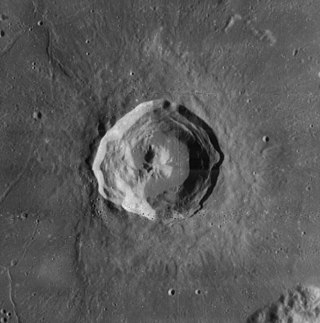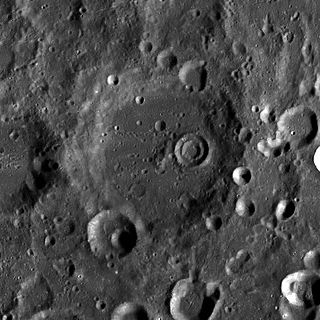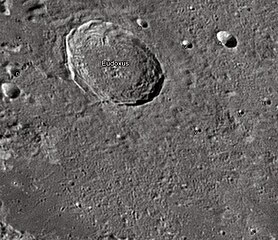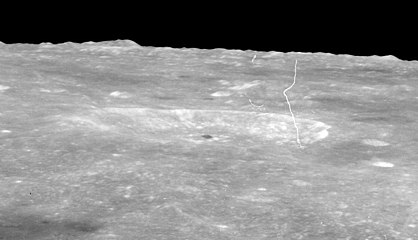
Anaxagoras is a young lunar impact crater that is located near the north pole of the Moon. It lies across the larger and more heavily worn crater Goldschmidt. To the south-southeast is Epigenes, and due south is the worn remains of Birmingham.

Faraday is a lunar impact crater in the southern highlands of the Moon. It was named after British chemist and physicist Michael Faraday. It lies across the southeast rim of the larger crater Stöfler, and the northwest rim of Faraday forms a wide rampart across the otherwise flat floor of Stöfler. To the east of Faraday is Maurolycus.

Autolycus is a lunar impact crater that is located in the southeast part of Mare Imbrium. The crater is named after the ancient Greek astronomer Autolycus of Pitane. West of the formation is Archimedes, a formation more than double the size of Autolycus. Just to the north is Aristillus, and the outer ramparts of these two craters overlap in the intermediate stretch of the lunar mare.

Römer is a lunar impact crater that is located to the north of the Sinus Amoris in the northeast section of the Moon. It was named after Danish astronomer Ole Rømer. It lies in the southwestern part of the mountainous region named the Montes Taurus. It was unofficially named as Atatürk by astronomer Hugh Percy Wilkins in his lunar map, possibly due to the fact that the Montes Taurus are located in Turkey. To the west-northwest is the crater-bay Le Monnier, on the eastern edge of Mare Serenitatis.

Bürg is a prominent lunar impact crater in the northeast part of the Moon. It lies within the lava-flooded, ruined crater formation designated Lacus Mortis. To the south and southeast is the crater pair Plana and Mason. To the west, beyond the rim of Lacus Mortis, is the prominent crater Eudoxus.

Godin is a lunar impact crater located just to the south of the crater Agrippa, on a rough upland region to the east of Sinus Medii. Its diameter is 34 km. The crater was named after 18th century French astronomer Louis Godin. The ruined crater Tempel lies to the northeast, on the east side of Agrippa. Due south is the flooded remains of Lade.

Harpalus is a young lunar impact crater that lies on the Mare Frigoris, at the eastern edge of the Sinus Roris. To the southeast at the edge of the mare is the small crater Foucault, and to the northwest on the opposite edge is the walled plain named South.

Anuchin is a lunar impact crater that lies on the southern hemisphere on the far side of the Moon. It is located to the south of the larger crater Lamb, and to the north-northwest of Kugler.

Milne is a large lunar crater that is located in the southern hemisphere on the far side of the Moon, named after the British mathematician and astrophysicist Edward Arthur Milne. It lies to the northeast of the Mare Australe, and southeast of Lacus Solitudinis.

Bell is a lunar impact crater that is located on the far side of the Moon, just past the western limb. It lies in an area of terrain that is marked by many small craters, a number of which are satellite craters of Bell listed in the table below. Bell lies within two crater diameters of Laue to the north, and to the west of the smaller Helberg.

Schomberger is a prominent lunar impact crater that lies in the southern part of the Moon, in the area near the limb. It is located to the southwest of the crater Boguslawsky, and southeast of Simpelius. The relatively young satellite crater Schomberger A is nearly attached to the southern rim, and the much-aged Schomberger C lies just off the western rim.

Carpenter is a lunar impact crater in the northern part of the Moon, relatively close to the limb. At this position the crater is foreshortened and appears oval in shape. It is, however, very nearly circular in outline. The outer rampart to the south is adjoined to the old crater Anaximander, and the satellite formation Anaximander B lies along the western rim. To the northeast is Anaximenes.

Casatus is a lunar impact crater that is located near the southern limb of the Moon. The north-northeast rim of the crater overlies a portion of the slightly larger crater Klaproth. Along the western rim, Casatus A intrudes somewhat into the interior, producing an inward-bowing rim. To the southeast of Casatus is Newton.

Philolaus is a lunar impact crater that is located in the northern part of the Moon's near side. It lies within one crater diameter to the east-southeast of the flooded crater Anaximenes, and to the west of the smaller Anaxagoras. It overlies the older and heavily worn Philolaus C to the south.

Demonax is a lunar impact crater near the southern limb of the Moon. This location makes the crater difficult to observe due to foreshortening. The crater is also illuminated at a very low angle, when it is in the sunlit side. Demonax lies just to the north of the crater Scott, one of the south polar formations. To the north-northwest is Boguslawsky.

Pasteur is a large lunar impact crater, approximately 233 kilometers in diameter, belonging to the category termed a walled plain. It was named after French chemist and microbiologist Louis Pasteur. It lies on the far side of the Moon as seen from the Earth, just beyond the eastern limb. The vicinity of this crater is occasionally brought into view from Earth due to librations, although not much detail can be seen.

Crookes is a lunar impact crater that lies on the Moon's far side as seen from the Earth. It lies just to the southwest of the giant crater Korolev. To the southwest of Crookes is McKellar.

Hayn is a lunar impact crater that lies next to the northeast limb of the Moon. This location restricts the amount of detail that can be viewed from the Earth, as the western inner side is permanently hidden from sight. Observation of this crater can also be affected by libration, which can completely hide this crater from sight.

Das is a lunar impact crater on the far side of the Moon. It is located to the north-west of the walled plain Chebyshev. To the south-west of Das is the irregular crater Mariotte, and Von der Pahlen lies to the east-northeast. The crater was named after Indian astronomer Anil Kumar Das.

Green is a lunar impact crater on the Moon's far side. It was named after British mathematician and physicist George Green in 1970. Prior to that, it was designated Crater 216. It lies just to the west of the huge walled plain Mendeleev, and is nearly joined with the west-northwestern edge of the crater Hartmann.

























